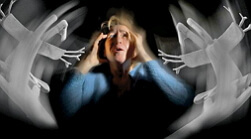Amenia
 The amputation of is the deepest form of obscuration of consciousness. In the states of twilight, there are several different subspecies, among which there is amenance. This manifestation occurs with severe pathologies and does not pass without a trace. In this case, the individual carries a significant danger to the environment and does not lead to contacting.
The amputation of is the deepest form of obscuration of consciousness. In the states of twilight, there are several different subspecies, among which there is amenance. This manifestation occurs with severe pathologies and does not pass without a trace. In this case, the individual carries a significant danger to the environment and does not lead to contacting.
Amenia is in psychiatry only one of the many forms of obscuration of consciousness.
In practice doctors, the occurrence of such a problem is very rare, so not everyone is able to distinguish such a severe form. An important role for a person in amenity is the timely sending to a medical institution, because only with the right appointments there is an opportunity to assist an individual.
What is amenity?
Amenia is a rather severe form of twilight confusion of the mind, which manifests itself as a diverse symptomatology. In this state, contact with the person is not attainable.
Amenity, not particularly different from most medical terms, sounds like a Latin language and means madness. And this is not surprising, because amenia is really a serious form of disrupting the activity of consciousness, the symptomatology of which is really only madness. It is noted that in ancient times, any manifestation of insanity belonged to amenity. Thus, many cases of schizophrenia and other manifestations related to amenia. But with the development of psychiatry in the form of a separate, quite successful science, the amenity began to be considered a kind of obscuration of consciousness, simply more severe than delirium. But even in this complex pathology there are light forms that arise as a reaction to the transient states of the organism. The amenity syndrome was first identified by Meinert and described it in the form of acute insanity. Thanks to the advancement of research in the future, these states were separated, having determined the main manifestation of mental disorganization. The
Syndrome of amenia has several forms. This classification is not decisive and does not need to be reflected in the diagnosis. Just to make it easier to understand what exactly is happening to the patient, there are such forms as:
• Catatonic-like form of amputation, from its name, includes catatonic inclusions, for example, it can be wax flexibility. A person can be in a pose of an air cushion or an embryonic posture. But this inclusion from the stupor is less common, more often there is a chaotic motionless motion. During this there are stereotyped repetitions of phrases or movements, echolalia, echopraxia.
• The incoherent form of amenations is the most typical. The person manifests an associative incoherence, can not adequately perceive the surrounding. With such individuals it is impossible to maintain contact.
• In hallucinatory-paranoid form of amenia, the individual sees hallucinatory images, while his delusional ideas correspond to the content of hallucinations. It may be that there is no delirium, but the patient hallucinates, then we can talk about a hallucinatory form. But in general, carrying out these boundaries is very conditional, more often a person has symptomatology for a few of all kinds.
Depending on the cause of the occurrence, the amenza is also classified into the following subspecies:
• Eepileptic amenia occurs in persons with confirmed epileptic disease.
• Pyruvic, or phenylketonuric amenia, occurs in children with phenylketonuria in the absence of treatment.
• The atonic form of amenity manifests itself as a common symptomatology, more often in people with atony.
• Maynert's amenation is used in general terminology and denotes any subtype of the amnesic state accompanying a particular disease.
Reasons for the change
Amenia develops under various severe diseases. Infectious diseases with severe leakage can also lead to similar symptoms. Now such diseases are not very common, but against the background of typhus, which is transmitted through food and water, it is possible. Appear complaints, according to the type of food poisoning, and then hectic fever with amenia is added. Diseases accompanied by sepsis can also lead to this condition. Some acute infectious diseases of the type of influenza can also be accompanied by an amenity. Influenza occurs with a high temperature and pronounced intoxication with inexpressive symptoms of catarrhal phenomena. Many hepatitis, including Botkin's disease, hepatitis A, also lead to similar symptoms, especially with fulminant forms.
Syndrome of amenia, in general, can develop if the course of somatic pathology is burdened, for example, with cardiac, pulmonary or renal failure. Many rheumatological systemic diseases, such as lupus, dermatomyositis, also have a chance of aggravating with amenia. The appearance of this condition is greatly influenced by the duration of the pathology, malnutrition( starvation), prolonged illnesses, exhaustion and body, and spirit.
Amenia develops with almost any severe intoxication, so it can be expected with intoxication with poisons, drugs, alcohol and similar products toxic to brain tissue. Such poisons can be gas weapons, poison for rats or insects, some fertilizers and even food products. From drugs, preparations for anesthesia can be dangerous. After all, there are well-known cases when a person, going out from anesthesia, created something new. Antiviral, neuroleptic, antiarrhythmic and chemotherapeutic drugs are also dangerous. In severe allergic reactions, this condition is also possible. Perhaps the emergence of alcohol or drug abuse, with the abuse of these funds. The
Syndrome of amenia does not always manifest itself as a separate psychiatric problem. Most often, amenia accompanies other diseases of the psychiatric spectrum. In manic-depressive psychosis, there is a subspecies with obscurations of consciousness, it is in this subspecies that the appearance of amenia is possible. Amenia develops in schizophrenia, in the context of psychosis. Often, this symptomatology can develop in vascular pathology, as well as with atrophic degenerative changes in the brain in old age.
Light forms of amenations can be formed with loss of blood, overwork, prolonged surgical interventions. Many endocrinological diseases in the case of severe decompensation can also lead to an amnesic state. Such diseases include, in particular, the febrile disease, the pathology of the thyroid gland, which is often found in areas endemic for lack of trace elements needed for this gland.
Symptoms and signs of amputation
Amenia is a very characteristic symptomatology in psychiatry. The syndrome of amenia is manifested by severe characteristics. This pathology develops in a variety of diseases, so it is important to diagnose them, because they can cause mortal danger. The
Syndrome of amenia is described as confusion, it is often possible to add the affect of surprise or incoherence, in the form of associative incoherence. At the same time, a person is not able to perceive events occurring in a holistic way around, the relationship between objects and phenomena in such individuals eludes them and they are unable to retain it.
Patients snatch certain chaotic fragments from the situation, but are unable to link them together, integrity is absent. The patient's speech is monosyllabic - it's more like an absurd collection of words, and in special cases and sounds. The nature of speech is more often than usual, but perseverations may occur. If delusional ideas appear, they are intermittent, unstable, but more often they are completely absent altogether. Sometimes some sets of words or words can be repeated in the form of echolalia and verbigrations. The affect is mostly unstable, can change or completely disappears. Human movements are disorderly, chaotic, with excitation reaching motor hyperkinesis, and sometimes there are echopraxia. Personality orientation is absent, at the place of stay and in time the individual is also disoriented. Such a person makes an impression absolutely and irrevocably confused, they are not able to say who they are, where they are, or assess the integrity of the situation. Memories for the period of the anomalous defilement are completely absent. After the completion of this state, the individual will not be able to remember anything. The duration of the amnesic state is mainly short-term, but in severe, prognostically negative cases, lengthening may be possible for several weeks, or even months.
Attention in patients with the aminamic syndrome is constantly slipping away, it is unstable and rapidly depleted. The patient's attention can not be kept on something definite, any new sign or sound completely takes his attention.
Although the person is also in motor excitement, but the movements do not exceed the border of the bed. In bed, he waves his limbs, something incoherent speaks or cries, often arches and turns. If their actions become more focused, they then defend themselves, close, then push it away, you might think about the presence of hallucinations of an intimidating composition. When the excitement reaches such a high level that the patient is unable to tolerate it, it becomes stupor, like a catatonic one. He can be given an uncomfortable position and he remains in it, he does not eat, does not fulfill any requests. If you pull out the pillow from under your head, he will hold it over the bed. Such a state with a long flow is dangerous and the person is fed through a probe.
Diagnosis of amputation
The first thing to be done in diagnosing this rather complicated state is to find out the reason. Depending on the cause of the disease, it is possible to find out in various ways. When infectious disease will help physical symptoms with microbiological studies, it is also important to measure the temperature. In case the cause is a somatic disease, you need to conduct suitable examinations: ECG, X-ray, ultrasound. If this is an endocrinological problem, you should take tests for hormones. To identify many neurological diseases or foci of damage to the brain tissue, MRI, as well as electroencephalography, is suitable.
Good technique is to collect anamnesis, so you can learn about suicidal tendencies or data about poisoning, which at this point can not be learned from the patient.
After this, you can already start working with the patient himself. First, it is important to identify the psychostatus. The patient is conscious, but disoriented both autopsychologically and alopsychically. The contact is not available, the conversation can not be supported. The speech is intermittent, indistinct, sometimes the patient whispers very softly some passages, and then suddenly something screams. Subjects in speeches can distinguish fragments of delusional ideas. From the behavior of the patient can be discerned whether he has hallucinations, if he shakes something, looks around, hides, then he sees something terrible. The mood of these patients varies unpredictably. Due to the severity of thinking, the patient is unable to adequately analyze the surrounding reality.
This disease is quite difficult to diagnose and it must be distinguished from other states of obscuration of consciousness.
Some forms of amenations are very similar to catatonia. To distinguish between these states, it is important to understand that the manifestations of catatonia in amenations are completely unstable, thus, with little effort, the pose can be changed. In the case of amenations, there is also incoherence and disconnection of speech with psycho products. Catatonia is a more serious disease, which has a number of its own, individual symptoms requiring different approaches.
Many people think that amenity and delirium are almost the same thing. And some doctors even refer to the subtype of delirium, but in fact, amence is a heavier form, which sometimes has delirium in its structure. The main difference in the variability of delirious episodes. In the case of amputation, motor excitation acts within the bed, which can not be said of the classical delirium. In delirium, hallucinations are holistic, and in the ammentation of thinking and hallucinatory images are broken. In delirium there are clearings during the daytime, and when there is an amment, there are no moments of clarification.
This state can also be confused with a oneiroid, but in the case of onyroid, the person has a double orientation, and in case of an amputation, it is completely absent. In addition, with an onyroid, the individual looks at a dreamlike film, and when amenia is completely torn. Any of these pathologies are not delayed for months, in contrast to amenia.
Treatment of amputation
To relieve such a difficult condition, it is very important for the patient to be hospitalized, because in a home he is dangerous to others, and his condition will worsen and may even lead to death. First of all, it is important to understand what disease caused this unfavorable condition, and begin its treatment. With infectious diseases it is important to treat the cause. When the flu is used antiviral, Remantadin. If there are bacterial complications, antibiotics are added, Flemoclav 500,000 IU IV, Ciprofloxacin 100 ml. With hepatitis, pegylated interferons are Pegentron, Pegasys. In rheumatological diseases, anti-inflammatory drugs and monoclonal antibodies are used. If there is poisoning, then antidotes and general measures for poisoning are used.
The specific treatment is quite diverse, due to the extensive symptomatology, many drugs are suitable. It is very important to start the introduction of neuroleptics in time: Aminazine 2.5% 2-5 ml. In the presence of hallucinatory-delirious excitation we use Clopixol-acupase 50-150 ml 1-3 ml w / m, Fluansol Depot 20 mg / ml. Also anticonvulsive works well: Seduxen 0,5% solution 2,0-4,0 ml im. Sodium thiosulfate 30% 20 ml IV, Magnesium sulfate 25% 10-15 ml IV, Pantopon 2% 1 ml PO is also used.
Also, since excitation is very expressive, diazepam is used 30-50 mg, Elenium 40-50 mg IM, Phenazepam 5-10 mg orally. For the subsequent treatment, nootropics are used: Piracetam 6-8 mg to 20 mg, Aminalon 300-1000 mg / day, Acephan 300-1000 mg / day, Pyriditol 0.3-0.4 g for 3-6 months. These drugs influence the processes of energy in the brain tissues, promote the improvement of glucose utilization, affect the thalamo-pituitary system, facilitate energy metabolism, stabilize the oxidation-reduction processes and cerebral functions, consciousness, memory speech, and have a mild psycho-stimulating effect.



